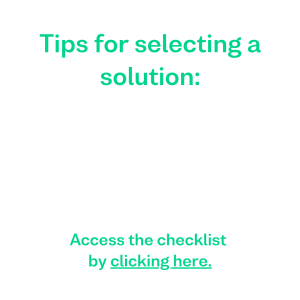7 Tips for a hassle-free data transfer to a digital archive
Believe it or not, migrating data into an archive doesn’t have to be complex or scary. In fact, with the right approach, support and planning, you can ease the process; reducing the risks, resource requirements and complexities involved.
Whether you’re planning your migration now or for the future, this blog post is for you. I aim to provide advice in reducing the hassle around transferring data to an archive.
So, without further ado, let’s explore ways to help streamline this process and ensure the integrity and accessibility of your valuable data.
1- Plan ahead
Prior to implementing and executing any activities around transferring your data, it is good practice to plan the steps you will be taking. Moreover, it is more beneficial to create a plan ahead of all data collection activity. This will allow thorough preparation of how to collect data in a way that accommodates your end-of-trial archiving process.

This is especially important in the context of complying with any relevant regulations; it’s important to be aware of the regulations that could impact your data and feed this into your plans.
Through doing this, you can outline how to approach topics such as archiving the data with a clear set of objectives in moving through the process. For example, where EU regulation 536/2014 requires data to be retained for 25 years, the selection of storing data must be able to accommodate this.
2 – Assess the data (size, format, complexity etc.)
Leading onto our next tip, it is best to first assess the data you have (or will have) before deciding where to archive the data. No matter what stage you are at with collecting the data, whether this may be managing live data or locking data at the end of a trial, it is important to understand information about your data. This can help craft the criteria for selecting an appropriate location (or solution) that best suits your data needs.
Ask yourself questions like:
- How large is the dataset that needs to be transferred (GBs, TBs etc.)?
- How many documents are in the dataset?
- How is it currently organised?
- How do you want it organised in the archive? And is it different to how it is currently organised?
- What sort of file formats make up the dataset?
This can help establish your organisational needs for an approach as well as assist in planning the necessary steps to make in preparing your data for transfer.
3- Deciding on where and how to archive the data
Deciding on where to archive the data, whether sourcing internally or externally, can feel like a difficult and complex decision to make. It must cater to all internal and external stakeholders that either have future access requirements 0r responsible for the retention of the records. It would be best to map out all the requirements into a checklist format based on your organisational needs (think IT capabilities or quality assurance).
If you select a third-party solution, ensure that you are confident that it suits the needs of your organisation. To do this, access demo videos through the third-party solutions and ask extensive questions.
4- Audit the data
At some point or another before migrating, the data will have to undergo an audit. Without going into too much detail, the overarching goal here is to ensure the accuracy, completeness, validity of your data before transferring it to the archive. For the purposes of migrating data for archival, this will directly impact the integrity and compliance of data for the long-term.
Auditing data gives opportunity for properly organising, labelling and documenting the data to ensure the long-term accessibility through facilitating the search and retrieval of specific data.
Archiving poor quality records will result in a poorly managed archive and create issues over the long-term. It’s important to spend time upfront, to reduce pain and issues in future.
5- Test the migration process
Regardless of approach, it’s important to test the migration process first.

If you have selected a third-party archiving solution, it’s best to verify how the data will be uploaded into the system. To do this, you’ll need to simply test the solution. Testing the upload process to the solution will help verify that data is being uploaded to the system correctly and to identify any issues that could occur. This should, in turn, give you more peace of mind in understanding the process and verifying its security.
If you have pursued an internal archiving solution, the above still applies. This can help refine the solution and process while training those all involved in using the systems.
6- Check the integrity of data
For the process of preserving data, the best way to ensure its integrity is to generate checksums for each file uploaded. If you have selected a third-party digital archive, then they should already do this.
Checksums are strings of characters that are mathematically calculated and assigned to a set of data. If the data is altered (even minimally altered) in any way, this would change the checksum that would be generated. This is then calculated every so often to ensure that the checksum remains the same to indicate that the data has not been altered (or become corrupted!). Before transferring data, use a checksum generator to calculate these. After data has been transferred, the checksum can be checked to make sure no errors or changes occurred during.
7 – Use and evaluate the archive
Now it’s time to migrate your data into the new selected solution. Even with careful evaluation of an archiving solution, it is still important to evaluate after implementation and use. This is to confidently validate that the archiving solution serves its purpose as planned and meets your organisation’s specific needs.
We recommend creating an evaluation scale, equipped with criteria that matches the pre-implementation criteria and ranking these based on how well you feel the solution meets these needs. It’s important to ensure that this is implemented across all users so that all needs are considered. Compare these rankings to your expectations prior to the selection of the solution up until the renewal date. Following this step will help with deciding whether you change archiving solutions.
Tip for archive evaluation: Ensure you communicate any concerns with your supplier/team as they may be able to alter your system or meet your needs accordingly.
In summary…
Transferring data into an archive doesn’t have to be a resource intensive or overwhelming task. By following the tips outlined in this blog post you can assist in streamlining the process. Remember to prioritise data accuracy, integrity, and compliance throughout the entire process. With careful planning and attention to detail, you can reduce the hassle and achieve a seamless transition to an archive, preserving your data for the long term.
And if you ever need support with your transfer, our friendly team of migration experts are always happy to help. Contact us today.

Caitlin Morris
Caitlin is the Content Marketing Manager at Arkivum. She joined the company in 2022 and is responsible for internal and external content creation and management. Caitlin has over 4 years of business and marketing experience.
Get in touch
Interested in finding out more? Click the link below to arrange a time with one of our experienced team members.
Book a demo